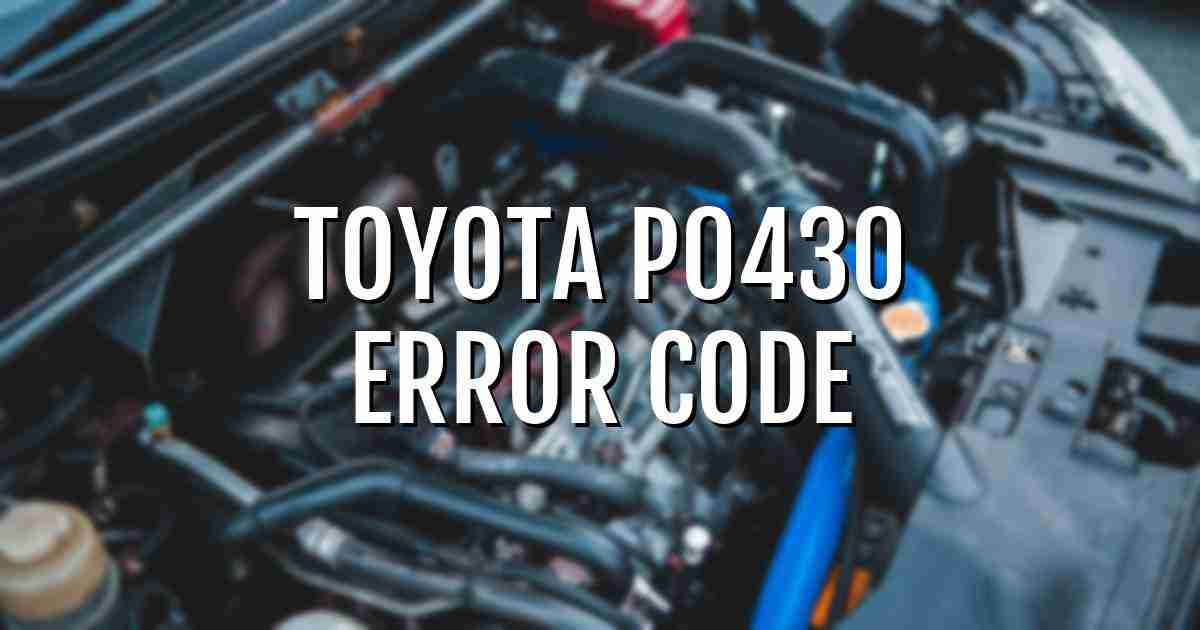The OBD code P0430 for Toyota indicates an issue with the Threeway Catalyst Converter Bank 2 efficiency.
Symptoms include the Engine Light being ON.
Causes may include a faulty catalyst converter, A/F sensor, oxygen sensor, or fuel injector.
It’s a serious issue that affects emissions.
To fix, inspect and potentially replace the faulty components and check wiring harness and connectors for damage.
| Repair Importance Level | 6.67 (Out of 10) |
| Estimated Repair Time | Approximately 1.0 hour |
| Repair Difficulty Level | 6.67 (Out of 10) |
I know how frustrating it is to see that warning light pop up again and again. You don’t need to spend money at the mechanic just to clear it. With this pocket-friendly automatic car scanner, you can do it yourself in seconds and and avoid the time and inconvenience of driving to a mechanic. Just plug it in, connect to your Android or iOS phone, and instantly see live data. Understand the fault code, clear it right away, and decide if it’s something urgent or if you’re good to drive. It even monitors your car and sends notifications to your phone, so you’re always in control. Simple, fast, and stress-free—today’s offer price!
Symptoms of the Toyota p0430 OBD Code
The vehicle may experience a decrease in fuel efficiency and the check engine light may illuminate.
- Symptoms: Check Engine Light ON.
- Decreased fuel efficiency.
- Rattling noise from the exhaust system.
Causes of the Toyota p0430 OBD Code
Do you know you can clear most fault codes—but some could mean serious danger? Don’t take chances with your safety or your family’s safety. This budget-friendly car scanner makes it easy to clear fault codes in seconds while showing you exactly what’s wrong. Plug it in, connect to your Android or iOS phone, and instantly check live data. You’ll know if it’s a minor issue you can clear or something serious that needs attention—so you can drive safely and stress-free. (Today’s Deal)
Possible reasons for Toyota P0430 include faulty catalytic converter, oxygen sensor, or exhaust leak.
- P0430 can be caused by a gas leak from the exhaust system.
- A faulty Threeway Catalyst Converter Bank 2.
- A faulty Air Fuel Ratio (A/F) Sensor Bank 2 (Sensor 1 or Front Sensor or Upstream Sensor).
- A faulty Heated Oxygen Sensor Bank 2 (Sensor 2 or Rear Sensor or Downstream Sensor).
- Or faulty fuel injector(s).
Fixing Toyota Error Code p0430 Step By Step
Addressing fault code P0430 on a Toyota involves diagnosing and repairing the catalyst system efficiency below threshold in bank 2.
- To fix Toyota OBDII code P0430, first, review the ‘Possible Causes’ mentioned above and visually examine the corresponding wiring harness and connectors.
- Ensure to check for any damaged components and inspect the connector pins for signs of being broken, bent, pushed out, or corroded.
- Next, perform a thorough inspection of the catalytic converter to check for any physical damage or internal deterioration.
- If the catalytic converter appears to be faulty, replace it with a new one.
- Finally, clear the fault code using a scan tool and test drive the vehicle to ensure the code does not return, indicating a successful repair.
Cost Of Fixing Toyota p0430 Fault Code
The repair for Toyota P0430 involves diagnosing and fixing issues with the catalyst system efficiency of bank 2.
The cost to diagnose and fix a Toyota OBD code P0430 typically ranges from $75 to $150 per hour for labor rates.
With an estimated repair time of 1. 0 hour, the total cost can be around $75 to $150, depending on shop rates and the complexity of the issue.
Details of the Toyota p0430 OBD Code
Code P0430 in a Toyota indicates a catalyst system efficiency below threshold in bank 2.
Code P0430 for Toyota vehicles means that the catalyst system efficiency is below the threshold for the bank 2 catalytic converter.
This code is triggered by the Engine Control Module (ECM) after monitoring the oxygen sensor signals before and after the catalytic converter.
If the downstream oxygen sensor signal mimics the upstream sensor signal, it indicates that the catalytic converter is not functioning properly in reducing emissions.
This code is specific to the catalytic converter on bank 2 of the engine.
Mechanic’s Tech Notes
Detailed information on diagnosing and repairing Toyota code P0430 related to catalyst system efficiency below threshold (bank 2).
To diagnose and fix OBDII code P0430 on a Toyota, start by checking the oxygen sensor (bank 2 sensor 2) using a voltmeter to ensure it is functioning correctly.
Next, inspect the catalytic converter for any damage or clogging.
Use a scan tool to monitor the oxygen sensor data and catalytic converter efficiency.
If the converter is faulty, replace it.
Additionally, check for exhaust leaks before the converter.
Reset the code after repairs and perform a road test to ensure the issue is resolved.
FAQ
Common causes of OBD code P0430 in a Toyota: Faulty Threeway Catalyst Converter Bank 2, Faulty A/F Sensor Bank 2, Faulty Heated Oxygen Sensor Bank 2.
Diagnose P0430 in Toyota: Check for gas leaks, faulty catalyst converter, A/F sensor, O2 sensor, or fuel injector. Inspect wiring and connectors for damage or corrosion.
Driving with OBD code P0430 may cause further damage to the catalytic converter. Check for gas leaks, faulty sensors, and wiring issues for proper diagnosis and repair.

Wrap Up
If your Toyota triggers OBDII code P0430, you may notice decreased fuel efficiency, a rough idle, or a lack of power.
This code typically indicates a failing catalytic converter, faulty oxygen sensor, or exhaust leak.
To address Toyota OBDII code P0430, start by inspecting the oxygen sensor’s wiring and connectors for any damage or corrosion.
Check for exhaust leaks near the sensor and ensure the catalytic converter is functioning correctly.
If necessary, replace the oxygen sensor or catalytic converter to resolve the issue.

